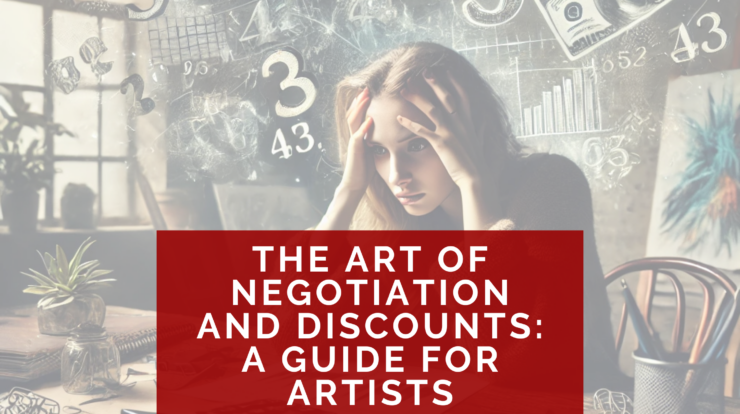
Negotiation, discounting, and promotional sales are all valuable tools in an artist’s sales process, yet many artists hesitate to use them. Some see negotiation as an affront to the value of their work, while others fear that offering discounts will make their work seem less desirable. However, when used strategically, these tools can increase sales volume, improve cash flow, and help build lasting relationships with collectors.
Over the years, I’ve engaged in thousands of negotiations, both as a gallery owner and an art dealer. I’ve found that negotiation, when done right, is not about conceding value—it’s about finding a point of agreement that benefits both the artist and the collector. Let’s break down the concepts of negotiation, discounting, and promotional sales and how to implement them effectively.
Understanding Negotiation, Discounts, and Promotional Sales
While these terms are often used interchangeably, they have distinct roles in the sales process:
- Negotiation is a conversation initiated by the buyer, where they inquire whether there is flexibility on pricing. It’s a natural part of high-end and luxury markets, including the art world. Many collectors enjoy the process and see it as part of the purchasing experience.
- Discounting is the act of reducing the price of an artwork to close a sale. It can result from a negotiation or be proactively offered by the artist or gallery.
- Promotional sales are proactive marketing efforts that offer special pricing for a limited time to encourage interest and urgency in purchasing artwork.
All three strategies overlap, and knowing when to use them effectively can help increase the likelihood of closing sales while maintaining the perceived value of your work.
Why Negotiation Is a Valuable Skill
Many artists resist negotiation because they see it as diminishing the value of their work. However, negotiation is a common practice in many industries, especially in luxury goods markets. Rather than viewing it as a personal attack, artists should see it as an opportunity to engage with a collector, find common ground, and build a relationship that may lead to future sales.
In reality, collectors don’t negotiate because they don’t value your work—they negotiate because they enjoy the process. Some feel a sense of accomplishment when they secure a discount, even a small one, and this positive experience increases their emotional investment in the piece.
If you refuse to negotiate outright, you may be leaving sales on the table. That doesn’t mean giving away your work for next to nothing, but it does mean recognizing that flexibility can help increase your sales volume while maintaining profitability.
Setting Yourself Up for Successful Negotiations
The key to effective negotiation is preparation. The most successful negotiations happen before the conversation even begins. Here’s how you can set yourself up for success:
1. Price Your Work with Room to Negotiate
When setting prices, consider building in a buffer that allows for some negotiation while maintaining your desired profit margin. For example, if you anticipate that you’ll need to offer discounts from time to time, price your work with a 10-20% buffer to accommodate that.
2. Know Your Minimum Acceptable Price
Before engaging in any negotiation, determine the lowest price you’re willing to accept. This will prevent you from making a decision in the heat of the moment that you’ll later regret.
3. Use a Written Offer Strategy
 One of the most effective ways to structure a negotiation is by presenting a written offer. Instead of verbally throwing out a lower price, write down the retail price, any additional costs (such as tax or shipping), and then present the final discounted price in writing. This small adjustment adds weight to your offer and often makes it feel more official and compelling to the buyer.
One of the most effective ways to structure a negotiation is by presenting a written offer. Instead of verbally throwing out a lower price, write down the retail price, any additional costs (such as tax or shipping), and then present the final discounted price in writing. This small adjustment adds weight to your offer and often makes it feel more official and compelling to the buyer.
Example:
- Retail Price: $5,000
- Sales Tax: $180
- Shipping: $250
- Total: $5,430
- Special Courtesy Price: $4,700 (All Inclusive)
By showing additional costs and then offering a clean, rounded number, buyers are more likely to accept the offer without further haggling.
Using Discounts and Promotional Sales Strategically
While negotiation typically happens at the buyer’s request, you can also proactively use discounting and promotions to increase sales under certain circumstances.
1. Multi-Piece Discounts
If a collector expresses interest in multiple pieces, consider offering a discount to encourage them to buy more than one. Instead of calling it a “discount,” refer to it as a “collector’s courtesy.”
Example: “If you’re interested in both of these pieces, I’d be happy to extend a 10% collector’s courtesy to you.”
2. First-Time Buyer Incentives
For new collectors, a small incentive can help encourage them to make that first purchase. This can be a discount or an added value like free shipping or a signed print.
3. Seasonal or Event-Based Promotions
If you have slow periods during the year, offering a limited-time promotion can help increase sales. However, be careful not to train your buyers to expect discounts all the time. Use promotional sales sparingly and strategically.
4. Follow-Up Incentives
If a potential buyer expresses interest but hasn’t made a purchase, a follow-up email with a “thank you” incentive can be effective. Instead of offering a discount upfront, follow up with an additional piece of information (such as an artist bio) and only offer an incentive if the buyer still hesitates.
The Numbers Behind Negotiation
At Xanadu Gallery, we track how often negotiation and discounting play a role in closing sales. Here are some key insights:
- Only 14% of sales involve a discount—meaning 86% of buyers pay full price.
- The average discount applied was 12%.
- When applied across all sales, the actual cost of discounts was only 1.5% of total revenue.
This data shows that negotiation does not devalue artwork when used strategically. Instead, it helps close sales that might not have happened otherwise, increasing overall revenue.
Final Thoughts
Negotiation and discounting are tools—when used wisely, they can help increase your sales while maintaining the value of your artwork. The key is to have a strategy, set your pricing accordingly, and approach negotiations with confidence rather than hesitation.
Instead of fearing negotiation, embrace it as an opportunity to engage collectors, build relationships, and move your artwork into the hands of appreciative buyers. With practice and preparation, you’ll find that negotiation is not about giving up value—it’s about closing more sales at the right price.
Share Your Thoughts, Questions and Experiences
I’d love to hear your thoughts on this topic! Do you have experiences with negotiation that have worked well (or not so well)? Share your comments and questions below!
Thank you for the insight, I had not thought about negotiation this way. I love the thought of being prepared, and having the answers already prepared.
Start the discussion by Know Your Client!!! In my palm desert gallery operation there was no need to qualify the clients so negotiations were expected and would be realistic. In the smaller gallery/frame shops it was not uncommon to negotiate on pieces over 1000 because it was a bigger portion of the clients potential income and thus was often the deciding factor between purchase or look and dream. Know the basic nature of your client base and begin from there. The other factor is knowing the value that can realistically be asked from that nature/income level of client. Price can be too high or often TOO LOW and both will kill a sale. When i look at an artists work i assess it based on the venue they are presenting it in. The same work in a gallery or exclusive show venue will need to be presented according to that venue and clients expectations. 50$ in the craft show, 250$ in the small art fair venue, 750$ in the regional/local gallery, 5000$ in the upper end galleries and so on . The van gogh at 50 million is intrinsically no different than the 50.00 piece in the craft show excepting centuries of promotion, placement and expectations of value. Negotiate based on your client NOT upon your desperation for a sale. If you need more money show in a different place to different clients.